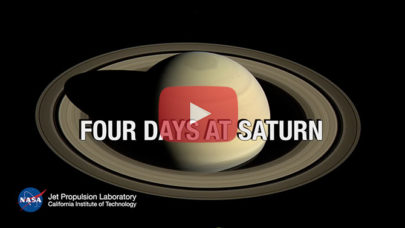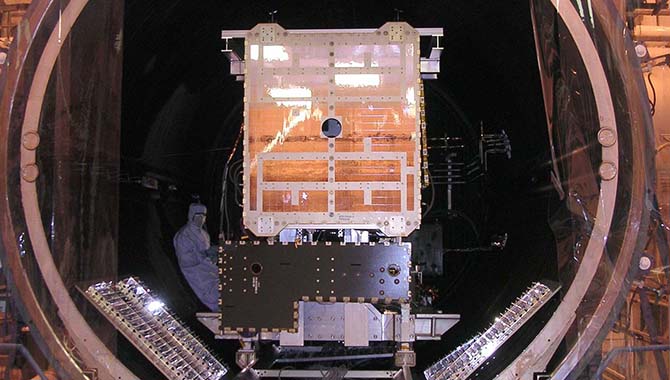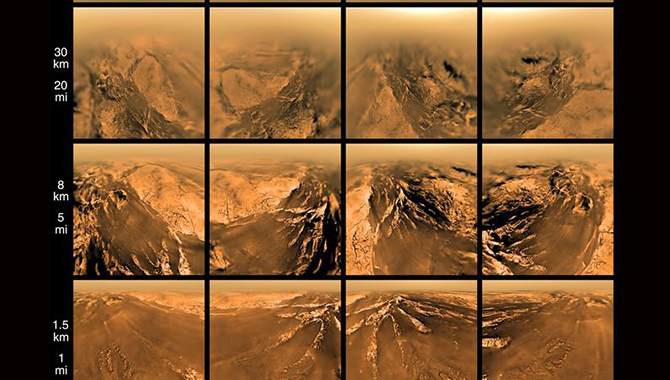
This image depicts Cassini’s trajectory during the final phases of its mission. The 22 Grand Finale orbits are shown in blue. The final orbit, indicated in orange, will take place on September 15, 2017.
Image credit: NASA/JPL-Caltech
After nearly two decades, NASA’s Cassini spacecraft will conclude its mission with a series of dives into the narrow gap between Saturn and its rings.
Cassini blasted off from Cape Canaveral on October 15, 1997 to explore the Saturnian system and deliver the Huygens probe to Titan, Saturn’s largest moon. According to Cassini project manager Jim Maize, the mission was an international triumph.
“We had nineteen nations and three space agencies contributing hardware to the Cassini-Huygens mission,” he said during a conference about Cassini’s final mission segment, highlighting the many successful aspects of the international collaboration. “The absolutely brilliant, creative, and innovative mission design. The astonishingly accurate navigation. The flawless engineering. And the meticulous melding together of 12 disparate scientific investigations into a cohesive whole that has essentially rewritten the books on Saturn. It is just a phenomenal achievement.”
Cassini arrived at Saturn in July 2004. Six months later it jettisoned the Huygens probe, which became the first human-made spacecraft to land on a moon in the outer solar system. Together, Cassini and Huygens uncovered the unexpected landscape of cloud-shrouded Titan, revealing the moon to be surprisingly Earth-like, with mountains, lakes, rivers, and seas.
Jim Green, director of NASA’s Planetary Science Division, recounted that first interaction with Titan. “[Huygens] settled through the atmosphere, landing down on the surface, making spectacular measurements of the temperature, the density, and the composition of the atmosphere. Cassini continued to make other observations of Titan, telling us a lot about the liquid that’s on its surface.” That liquid turned out to be methane, not water, dashing hopes of finding life on Titan.
Hope reemerged as the mission investigated a different Saturnian moon: Enceladus.
Cassini discovered that along its south polar region, the small moon emits a plume of particles made up of ice water, vapor, and complex organic compounds. It appears Enceladus contains a warm, underground saltwater ocean that may harbor the potential for life.
This extraordinary discovery now has a direct bearing on the future of Cassini. With the spacecraft running out of fuel and the mission coming to an end, NASA can’t risk leaving the spacecraft intact near Enceladus, as any inadvertent contact with the moon could contaminate potential life. So mission designers made a recommendation that would maximize the science return at the end of the mission while ensuring Enceladus remains safe.
“Since we want to stay at Saturn, the only choice was to destroy it in some controlled fashion,” said Maize. “We are going to dive into the gap between the rings of Saturn and Saturn’s atmosphere. A place no one—no spacecraft—has ever gone. We’re going to be going 70,000 miles per hour into the 1,200 mile-wide gap.” He added, “Even a piece of sand, at that velocity, will take out one of our instruments. […] So this is something we wouldn’t want to really try any other time. But now it is the time.”
This final phase, known as the Grand Finale, will kick off with a final Titan flyby that kinks the spacecraft’s flight path and sends it into a series of proximal orbits—22 in total—inside the rings of Saturn. The first will take place on April 26.
Over the course of its Grande Finale, Cassini will reach speeds of up to 76,000 miles per hour and get very close to the planet’s cloud tops. “[T]he distance gets down to about 1,800 miles, which is very roughly the distance across the continental United States,” said Joan Stupik, Cassini guidance and control engineer at NASA’s Jet Propulsion Laboratory (JPL). She added, “In space terms, that’s a really short distance.”
As it flies through the rings, Cassini will answer lingering questions about the Saturn system. For example, it will meticulously measure the mass of the rings to reveal their age and origin. “If the rings are a lot more massive than we expect, perhaps they’re old—as old as Saturn itself—and they’ve been massive enough to survive the micrometeroid bombardment and erosion, and leave us with the rings we see today,” said Cassini project scientist Linda Spilker. “Now on the other hand, if the rings are less massive, perhaps they’re very young, maybe forming as little as 100 million years ago. Maybe a comet or a moon got too close, got torn apart by Saturn’s gravity, and we have the rings that we see today.”
Cassini will also determine the composition of the ring particles. “We know that Saturn’s rings are 99% water ice, but we’re not certain about that other 1% non-icy constituent. What is it made of? Could it be tiny grains of iron? Silicates? Organics? A mix of all three?” asked Spilker. “When our cosmic dust analyzer goes through the ring plane, we’ll scoop up ring particles and directly taste and measure the composition of those particles.” Eventually, as the spacecraft closes in on Saturn, its instruments will target the mysterious planet itself, measuring the size of its rocky core, exploring the composition of its atmosphere, and examining its magnetic field.
The mission will end with the 22nd proximal orbit on September 15, 2017. The legacy of Cassini, however, will continue. The spacecraft’s multiple flybys of Titan revealed extraordinary information about the moon—“just like an orbiter,” said Green. NASA will follow that model for an upcoming mission at Jupiter’s moon Europa.
As for the Saturnian system, it won’t be left alone for long. “[W]e have released an Announcement of Opportunity called New Frontiers that allows further exploration of Enceladus—but also Titan,” said Green. Titan is a particularly compelling target because it challenges the notion that DNA is the only basis for life. “Perhaps it’s based on a completely different system, and Titan might be able to give us that hint, or that view, into an environment that’s so different but still could support fascinating types of life.”
“We call that field of research ‘weird life,’” he added. “That’s a gateway to what we might find for exoplanets.” If so, this represents one more way in which Cassini has revealed new possibilities in the search for life beyond Earth.
To learn more about NASA’s exploration of Saturn and its moons, read these APPEL News articles about Cassini’s 15th anniversary, the challenges of delivering the Huygens probe to Titan, and Pioneer 11: the first spacecraft to pave the way past Saturn.










